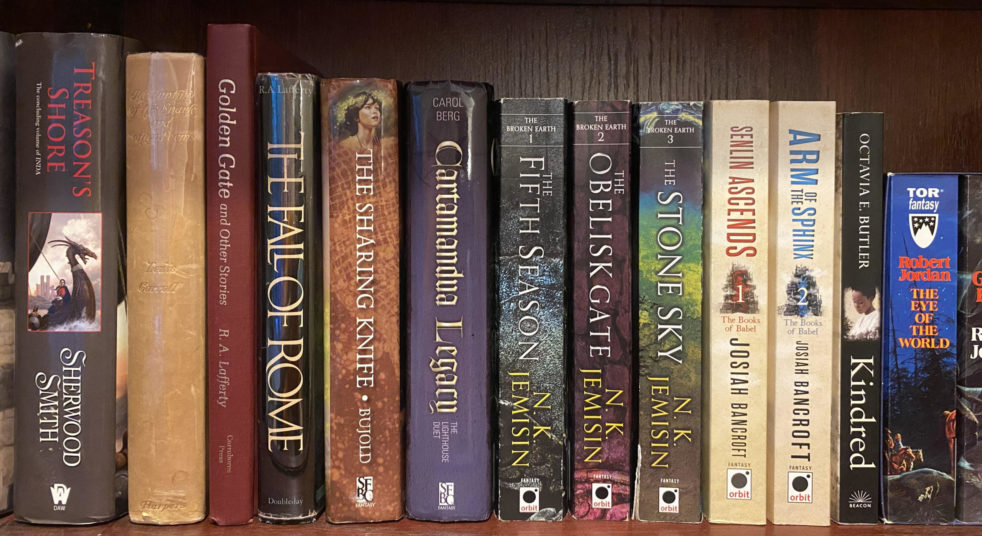
Gideon the Ninth is one of those books that has been incredibly popular in my online circles for the last year or two, but where I needed a push to actually move it to the top of my list. That push came in the form of its sequel being nominated for the Hugo Award for Best Novel. I still approached with some trepidation, having heard it was meme-heavy in a way that clearly resonated with many but sounded awkward to me, and having heard way too much Rule of Cool in the sales pitches (it’s “lesbian necromancers in space”! But neither lesbians nor necromancers nor space are going to get me to read a book that I didn’t otherwise want to read). But, as the award nominations suggest, there is a lot to recommend Tamsyn Muir’s debut.
Despite all that I’d heard about Gideon the Ninth (including some important spoilers), I didn’t have a great sense of the plot going in. Having read the book, I now understand why–it’s a slow-developing plot that doesn’t really start becoming clear until fairly late. The setup is that Gideon, our foul-mouthed swordswoman heroine, must serve as a bodyguard to powerful necromancer (and Gideon’s personal enemy) Harrow, as Harrow and necromancers from seven other houses are brought to an isolated and mostly-abandoned mansion to determine whether they are worthy to become immortal servants of the Emperor. Beyond that, the characters have to figure things out for themselves, and the readers must learn right along with them.
Despite having so many concerns about the tone, I thought Muir’s debut nailed the character voice. Yes, there are a whole lot of memes referenced, but it doesn’t feel like the author trying too hard to be clever so much as having a character speak in an informal vernacular. This particular vernacular is one of the extremely online in the late 2010s/early 2020s, and as such it may not age well or transfer to other demographics. But for a reader who’s used to hearing people talk like that, it’s pretty seamless, with deft transitions between the more educated third-person narration and the extremely colloquial thoughts and speech of a snarky swordswoman with a penchant for groan-worthy jokes.
The plot, on the other hand, goes beyond slow-building and into the unnecessarily opaque. Part of the opacity is a clear stylistic choice, with our point-of-view character having no real interest in either necromancy or the goals of the person she’s there to protect, leading her to overlook the tension building offscreen until it eventually spills over into occurrences too shocking to ignore. But the reader needs some hook for their interest in the first half of the book, and the goals of a person that Gideon is avoiding don’t really serve. We do see some hints of interesting mystery, but it’s not enough to sustain the first half of the story, and the supporting cast is too large and unwieldy to stand in the gap. The more promising hook is the rivalry between Gideon and Harrow, characterized by intense animosity from the very first chapter and being pushed inexorably by the plot toward a direct reckoning. But, although Gideon has a good idea of why Harrow hates her (and vice versa), we don’t actually see any of the backstory until nearly three-quarters of the way through the book. So the prospective hook is just decontextualized hatred, which just doesn’t have the weight of real history between them. Both the external plot and the interpersonal plot develop in truly interesting ways, but by holding back so much of the foundation, Muir fails to capture the interest necessary for the payoff to carry the weight it should have.
Overall, Gideon the Ninth has a lot to offer, with every scene expertly written, an intriguing external conflict that becomes clearer toward the end of the book but leaves plenty of room for a sequel, and some excellent interpersonal development. But the structural problems hold the book back from greatness, playing everything close to the vest and failing to build the foundational tension on which the late developments rest.
Recommended if you like: mystery plots with large casts, snarky protagonists, enemies forced to work together with slow burn interpersonal progression.
Can I use it for Bingo? I believe it serves as hard mode for Genre Mashup (fantasy, sci-fi, mystery, maybe even horror?), Mystery Plot, and Gothic Fantasy and is also a Debut.
Overall rating: 13 of Tar Vol’s 20. Three stars on Goodreads.
